- Joined
- Oct 9, 2007
- Messages
- 47,510 (7.49/day)
- Location
- Hyderabad, India
| System Name | RBMK-1000 |
|---|---|
| Processor | AMD Ryzen 7 5700G |
| Motherboard | ASUS ROG Strix B450-E Gaming |
| Cooling | DeepCool Gammax L240 V2 |
| Memory | 2x 8GB G.Skill Sniper X |
| Video Card(s) | Palit GeForce RTX 2080 SUPER GameRock |
| Storage | Western Digital Black NVMe 512GB |
| Display(s) | BenQ 1440p 60 Hz 27-inch |
| Case | Corsair Carbide 100R |
| Audio Device(s) | ASUS SupremeFX S1220A |
| Power Supply | Cooler Master MWE Gold 650W |
| Mouse | ASUS ROG Strix Impact |
| Keyboard | Gamdias Hermes E2 |
| Software | Windows 11 Pro |
Australian tech publication ARN posted these pictures from a Radeon R7 and R9 series press event held down-under, which covers AMD's add-in board (AIB) partner-branded graphics cards. The products appear to only include the R7 260X, R9 270X, and R9 280X, hinting at the possibility that the three will be the first SKUs in the series that AMD will launch in the market (ahead of their respective "non-X" variants). In addition, AMD also showed off a handful upcoming notebooks running mobile variants of these chips.

ASUS revealed its trio, which include DirectCU models only. The R7 260X features the lightweight variant of the cooler, which has been used on previous generation HD 7700 and HD 7800 series products by the company. The R9 270X and R9 280X DirectCU cards, on the other hand, feature heavier, and newer versions of the cooler, which have been featured on some of the high-end GeForce GTX 700 series products. Each card will include sub-variants that either stick to AMD reference clock speeds, or feature factory-overclocked speeds.
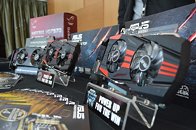
MSI's lineup includes models from its Gaming Series. The company appears to be using the same meaty Twin Frozr IV cooling solution on its R9 270X and R9 280X graphics cards. The cooler proved its mettle on the likes of GTX 770 and GTX 780 from the company's GeForce GTX lineup, offering some very low noise levels for the cooling performance on tap, and one could expect the same show from the company's Radeon lineup, as well. As with ASUS' DirectCU lineup, MSI's cards could each ship in reference- and factory-overclocked variants.
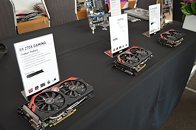
Sapphire appears to be tapping into its renowned Vapor-X cooling solutions, which feature vapor-chamber cooling plates that draw heat from the GPU more efficiently (at least in principle). The cooling solutions appear to be dual-slot across the board, compared to bulky triple-slot solutions on the previous generation HD 7900 series, with swanky new cooler shrouds. Sapphire is sticking to blue colored PCBs on some of its cards.
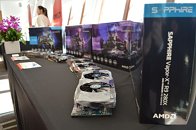
HIS' lineup doesn't appear to be too different from its previous-generation. You find the familiar looking IceQ X2 and IceQ X cooling solutions on the company's R9 280X and R9 270X cards, found on previous generation HD 7900 series and HD 7800 series products, which make us wonder if the company has completely rebranded them. As with the others, HIS will put up reference- and factory-overclocked variants of each design.

The story repeats with GIGABYTE, which showed off its R9 280X and R9 270X cards to look not very different from its previous generation HD 7900 and HD 7800 series WindForce graphics cards. The WindForce cooling solutions feature an extremely dense compound aluminium fin array heatsink, and a trio of 80 mm fans, which are inclined at an angle that pushes hot air out of the case. Again, reference- and overclocked-variants for these cards.
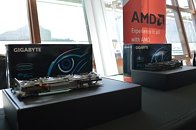
Lastly, there's XFX and PowerColor. The companies showed off their entire lineups barring the R9 290X, starting with the R7 240, to R7 250, R7 260X, R9 270X, and R9 280X, with their boxes, and the cards themselves. Unlike the others, PowerColor at least made an effort to make its cards look new, by using new cooler shroud designs, black colored PCBs across the board, and of course, new packaging. Some of the cards feature familiar PCS+ and Devil13 cooling solutions under the hood.
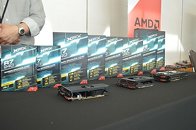
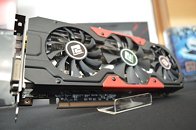
As mentioned earlier, AMD showed off notebooks running upcoming mobile variants of its new chips. Under the hood, today's all-in-one desktops aren't too different from notebooks, running mobile variants of CPUs and GPUs, and hence, some of them were shown to the audience, too.




View at TechPowerUp Main Site

ASUS revealed its trio, which include DirectCU models only. The R7 260X features the lightweight variant of the cooler, which has been used on previous generation HD 7700 and HD 7800 series products by the company. The R9 270X and R9 280X DirectCU cards, on the other hand, feature heavier, and newer versions of the cooler, which have been featured on some of the high-end GeForce GTX 700 series products. Each card will include sub-variants that either stick to AMD reference clock speeds, or feature factory-overclocked speeds.

MSI's lineup includes models from its Gaming Series. The company appears to be using the same meaty Twin Frozr IV cooling solution on its R9 270X and R9 280X graphics cards. The cooler proved its mettle on the likes of GTX 770 and GTX 780 from the company's GeForce GTX lineup, offering some very low noise levels for the cooling performance on tap, and one could expect the same show from the company's Radeon lineup, as well. As with ASUS' DirectCU lineup, MSI's cards could each ship in reference- and factory-overclocked variants.

Sapphire appears to be tapping into its renowned Vapor-X cooling solutions, which feature vapor-chamber cooling plates that draw heat from the GPU more efficiently (at least in principle). The cooling solutions appear to be dual-slot across the board, compared to bulky triple-slot solutions on the previous generation HD 7900 series, with swanky new cooler shrouds. Sapphire is sticking to blue colored PCBs on some of its cards.

HIS' lineup doesn't appear to be too different from its previous-generation. You find the familiar looking IceQ X2 and IceQ X cooling solutions on the company's R9 280X and R9 270X cards, found on previous generation HD 7900 series and HD 7800 series products, which make us wonder if the company has completely rebranded them. As with the others, HIS will put up reference- and factory-overclocked variants of each design.

The story repeats with GIGABYTE, which showed off its R9 280X and R9 270X cards to look not very different from its previous generation HD 7900 and HD 7800 series WindForce graphics cards. The WindForce cooling solutions feature an extremely dense compound aluminium fin array heatsink, and a trio of 80 mm fans, which are inclined at an angle that pushes hot air out of the case. Again, reference- and overclocked-variants for these cards.

Lastly, there's XFX and PowerColor. The companies showed off their entire lineups barring the R9 290X, starting with the R7 240, to R7 250, R7 260X, R9 270X, and R9 280X, with their boxes, and the cards themselves. Unlike the others, PowerColor at least made an effort to make its cards look new, by using new cooler shroud designs, black colored PCBs across the board, and of course, new packaging. Some of the cards feature familiar PCS+ and Devil13 cooling solutions under the hood.


As mentioned earlier, AMD showed off notebooks running upcoming mobile variants of its new chips. Under the hood, today's all-in-one desktops aren't too different from notebooks, running mobile variants of CPUs and GPUs, and hence, some of them were shown to the audience, too.




View at TechPowerUp Main Site
Last edited:









